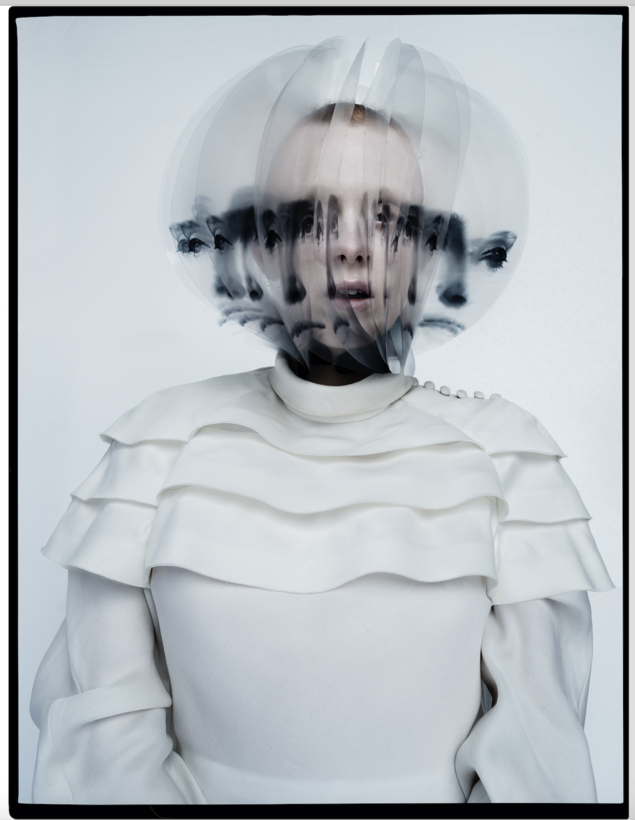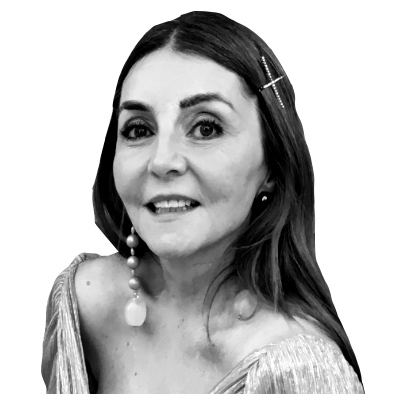Punks, drag queens, mods, men wearing dresses (or almost nothing at all), bra-less girls in men’s suits with severe bobs, tattoos, piercings, unctuous flesh and layers of tulle, pink hair, blue hair, who-gives-a-fuck hair—this is the scene on a recent evening at Annabel’s, London’s smartest members club, on the night of photographer Tim Walker’s after-party following the opening of “Wonderful Things,” his triumphant new show at the Victoria and Albert Museum. Amid all this flamboyance and peacocking stands Walker in a custom Stefano Pilati skirt-suit (one of five commissioned for the launch), with his co-host, British Vogue editor Edward Enninful, by his side. It could be a tableau vivant of the photographer’s work, a mash-up of London’s newly emerging beautiful oddities; the raw creative talent that has been slowly simmering and transmogrifying in the East End. Which is where, one week previously, I met with the quiet lensman in his spare and orderly studio.
An Upstanding Citizen
Walker, 48, sits at the head of a utilitarian office table that is dominated by photography books. He wears black shorts and a T-shirt, just back from a work-out. He is handsome, soigné but unshaven, lean, almost wiry. When he smiles, a distinct silver incisor glints. But it’s the way he speaks, with a soporific tranquility and restraint, that underscores the juxtaposition of this upright man and his voluptuously eccentric output. You stare into his eyes longer than you should; his diffident manner is so at odds with the curiosity cabinet of his work.
The V&A show marks the apex of a career which began in 1995, when British Vogue first published his work. It’s as if everything he has done in the interim—his first exhibition at the Design Museum, in 2008, his second at Somerset House, in 2012, and now both the V&A and the National Portrait Gallery hold his work in their permanent collections— anticipated this moment. Three years ago, the museum invited him to trawl through their extensive collection of relics and artifacts and choose pieces to photograph. He was drawn to the esoteric—a plaster cast of a fig leaf, a stained-glass window, a lacquered box, an Indian print, a fragment of the Bayeux Tapestry, an Aubrey Beardsley drawing—and then he captured the smallest details through photography. Fashion is used throughout, but as a prop, rather than the focal point.
Walker claims he wasn’t remotely academic at school. “I found it very difficult,” he says. “I was a late developer in every way. The way I sit in myself now, I’m centered, and I know what I’m about. But it took a long, long time to get there. I was so at odds with so many things. I wanted to satisfy my very hard-working parents and essentially conform, which is exactly what I shouldn’t have been doing. I should have been trailblazing my difference, my gayness, my individuality, how I saw the world. I was doing everything to hide that through shame.”
“I wanted to satisfy my very hard-working parents and essentially conform, which is exactly what I shouldn’t have been doing.”
His first camera was borrowed from his brother, so he could capture the meanderings of his adolescent vision, and he shows me images of his painstakingly detailed scrapbooks and drawings. “A lot of people confuse photography as a technical art; the mastering of a box,” he continues. “But people are always way more interesting than an inanimate box with a mirror in it … I could sit and look at people for hours.”
He says that he often photographs people using literary references such as C.S. Lewis and Lewis Carroll, whose Alice in Wonderland is a recurring theme in his work.”I always attribute Alice to my dad,” he says. “I have very strong memories of him reading to my brother and I. Alice explains the chaos of life. She, and Dorothy in The Wizard of Oz, mirror the pantomime and spookiness, as well as the power and beauty of all the different characters one comes across. I always like to think that the Queen of Hearts is just around the corner. You might meet her on the Tube, or bump into Tweedledee and Tweedledum.”
The Apprentice
During photography college in Exeter, the privately educated boy from the West Country interned at Condé Nast. Sarajane Hoare, the fashion director of British Vogue at the time, remembers the formally dressed, very serious young man who approached her for advice. ” I was struck by his politeness and respect; his mother brought him up very well,” she says. “I have been very protective of him my whole life.” Hoare told him to go to New York and find work with the best photographers; to learn about movement with Arthur Elgort and sex with Herb Ritts. Instead, he ended up as Richard Avedon’s fourth assistant, working on Versace campaigns.
Walker returned to the U.K., finished his degree, and worked commercial jobs at first, but he was soon fed up. He made a book of his black-and-white photos and returned to Vogue, where the new fashion director, Lucinda Chambers, gave him his first editorial job. When he teamed up with Kate Phelan, another Vogue editor, his aesthetic began to coalesce, a process that was solidified when he met prop stylist Shona Heath. The two have been collaborating ever since; she most recently worked with Walker on his pieces commissioned for the V&A show. For the next decade, Walker shot for British, Italian, and American editions of Vogue, as well as for W and LOVE, cementing his status as one of the world’s most respected photographers.
It took him a decade of shooting fashion to truly appreciate what he calls “clothes that you die to photograph.” “Fashion is such a tricky and dangerous thing to get into bed with; it can override your voice, you can be squashed out by trends,” he says. Alexander McQueen, whom he met through Kate Moss, changed his perception. “I thought to myself, ‘My God, O.K.’ Those clothes were sublime, they made a photograph.” Today, he looks to Valentino’s Pierpaolo Piccioli for a similar hit. “What he does is art,” says Walker. “There’s a refinement and elevation which makes me thrilled to be a fashion photographer.”
He Walks in Beauty
But simple portraiture and mundane documentary photography does not interest him. “A repetitive notion of beauty in humankind becomes terribly boring, ” he explains. Which is why he turns to life’s characters for inspiration, referencing muses such as Tilda Swinton, Stella Tennant, and Karen Elson. “Karen was considered so alien-looking in the beginning, a bit of a freak. There was a lot of negativity thrown at her, and now she’s considered one of the most classically beautiful women,” he says. “Good on her, she owned that—she performed so she could change the way society perceives beauty.”
He recently shot author Margaret Atwood, who also appears in the V&A show. “She came in as a writer that we all know; I was very careful. But she chose all the clothes, and said things like, ‘That’s great, leave that behind, can we get a quill, a feather, a yellow glove?’ I liked her playfulness, and her understanding of the need to create.”
“A repetitive notion of beauty in humankind becomes terribly boring.”
Walker’s show is an outstanding, epigrammatic roller coaster. Images punch you in the face, blindside you, draw you closer, so you get lost for hours, uncovering layers of texture and meaning. You encounter people you know, but not as you know them. Tilda Swinton is photographed as Edith Sitwell, inspired by the museum’s Cecil Beaton portraits of the poet and critic. Walker references stained glass-windows and a painterly, classical composition to capture primary-colored Valentino cloaks. As a whole, the work bears witness to his artistic and intellectual progression—the esoteric reaches of his mind, how effortlessly he seems to find the absurd in the mundane. “Where I am now is where I was meant to start out,” he says.
Onwards and Upwards
This beautifully strange, quixotic man announces he is taking a six-month sabbatical to recharge his “drained battery.” The start of his V&A odyssey coincided with a painful split from his boyfriend of 20 years, and the show helped him lose himself in his work. Now he is happily in another relationship (“with a wonderful man,” he enthuses), but he wants to reflect, walk his dog, slow down, eat in his favorite restaurants, maybe illustrate a cookbook with his mother, and also, he says, “meditate through boredom, because that’s where the big fish are.” “Since I started the V&A conversation, the cultural landscape has had a tectonic shift, there’s been a massive earthquake,” he says. “The fashion industry has changed. It’s become less interesting for me.”
Back in Annabel’s, with Kate Moss, Naomi Campbell, and Karen Elson by his side, Walker is perfectly at ease. “Tim is a very magical person, and when you work with him, he transports you into his magical world,” says Moss. The joyous maelstrom of those who have come to pay homage, celebrating their differences and dissonant physicality, are here together, in multifold ways, because of him. That he might have somehow paved the way for them, however, is something he is unlikely to ever admit.
Vassi Chamberlain is an Editor at Large for AIR MAIL who lives in London

